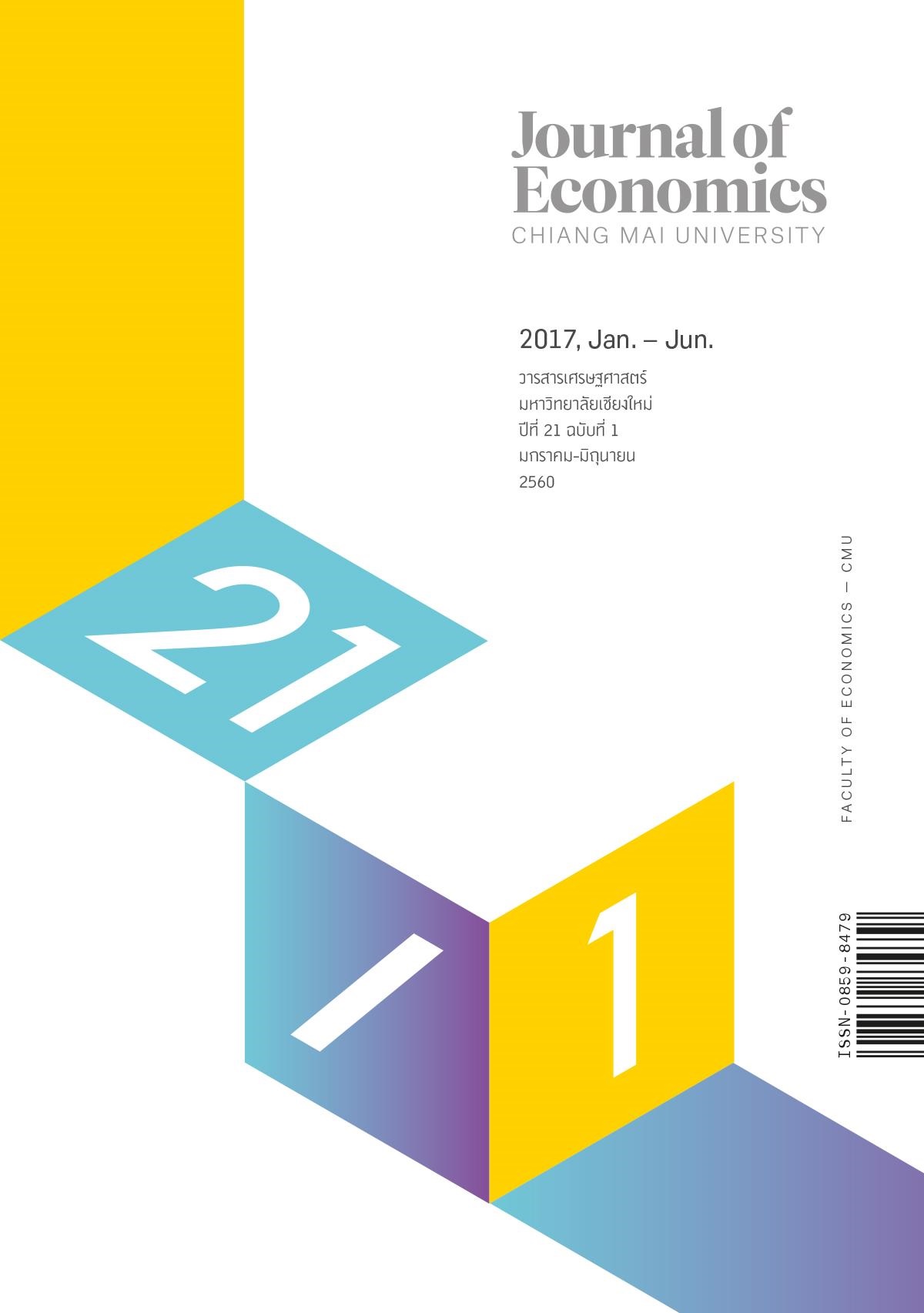การส่งผ่านอัตราแลกเปลี่ยนไปยังดัชนีราคาสินค้านำเข้าอุตสาหกรรมของประเทศไทย Exchange Rate Pass-Through to Industrial Import Price Index of Thailand
Keywords:
การส่งผ่านอัตราแลกเปลี่ยน, ดัชนีราคาสินค้านำเข้า, การส่งผ่านแบบอสมมาตร, Exchange Rate Pass-through, Import Price Index, Asymmetric Pass-throughAbstract
บทคัดย่อ
การวิจัยนี้มีวัตถุประสงค์ เพื่อศึกษาถึงการส่งผ่านอัตราแลกเปลี่ยนไปยังดัชนีราคาสินค้านำเข้าอุตสาหกรรมของประเทศไทย เพื่อวิเคราะห์ถึงขนาดของผลกระทบที่อสมมาตรของราคาสินค้านำเข้าในหมวดสินค้าหลัก ซึ่งประกอบด้วย สินค้าเชื้อเพลิง สินค้าทุน สินค้าวัตถุดิบและกึ่งสำเร็จรูป สินค้าอุปโภคบริโภค สินค้ายานพาหนะและอุปกรณ์การขนส่ง ข้อมูลอนุกรมเวลารายเดือนอัตราแลกเปลี่ยนบาทต่อดอลลาร์สหรัฐฯ ดัชนีราคาสินค้านำเข้าของไทย ดัชนีราคาสินค้านำเข้าของหมวดสินค้าหลัก ดัชนีราคาผู้ผลิตประเทศสหรัฐอเมริกา และดัชนีผลผลิตภาคอุตสาหกรรมของไทย ตั้งแต่เดือนมกราคม ปี พ.ศ. 2545 ถึงเดือนธันวาคม ปี พ.ศ. 2558 ถูกนำมาใช้ในสมการการส่งผ่านอัตราแลกเปลี่ยนไปยังดัชนีราคาสินค้านำเข้าอุตสาหกรรม ผลการศึกษาพบว่าอัตราแลกเปลี่ยนบาทต่อดอลลาร์สหรัฐฯ มีการส่งผ่านผลกระทบเชิงลบไปยังดัชนีราคาสินค้านำเข้าของไทยเฉพาะในหมวดสินค้าทุน สินค้าอุปโภคบริโภค และสินค้ายานพาหนะและอุปกรณ์การขนส่ง แต่อย่างไรก็ตาม ผลลัพธ์จากการศึกษานี้พบว่าไม่มีการส่งผ่านอัตราแลกเปลี่ยนแบบอสมมาตรในแต่ละหมวดสินค้านำเข้าของประเทศไทย
JEL: B22 B23 C22
Abstract
The purpose of this research is to study asymmetric exchange rate pass-through into industrial import price index of Thailand in order to determine whether the size of a change in the exchange rate does matter for industrial import price index. The main categories of industries include fuel, capital goods, raw materials and semi-finished goods, consumer products, and transportation and transportation equipment. This study employed the monthly data of THB/USD exchange rate, the baht-denominated import price index, the import price index of the major categories, the US producer price index, and the manufacturing production index – so as to construct exchange pass-through model. The data are from January 2002 to December 2015. The results show that there is a negative exchange rate pass-through associated with the import price index of capital goods, consumer products, and transportation and transportation equipment. However – the underlying results highlight that there is no evidence of asymmetric exchange rate pass-through for the whole categories.
JEL: B22 B23 C22
Downloads
Published
Issue
Section
License
All opinions and contents in the CMJE are the responsibility of the author(s). Chiang Mai University Journal of Economics reserves the copyright for all published materials. Papers may not be reproduced in any form without the written permission from Chiang Mai University Journal of Economics.
ข้อคิดเห็นที่ปรากฏและแสดงในเนื้อหาบทความต่างๆในวารสารเศรษฐศาสตร์มหาวิทยาลัยเชียงใหม่ ถือเป็นความเห็นและความรับผิดชอบโดยตรงของผู้เขียนบทความนั้นๆ มิใช่เป็นความเห็นและความรับผิดชอบใดๆของวารสารเศรษฐศาสตร์ มหาวิทยาลัยเชียงใหม่
บทความ เนื้อหา และข้อมูล ฯลฯ ในวารสารเศรษฐศาสตร์มหาวิทยาลัยเชียงใหม่ ถือเป็นลิขสิทธิ์เฉพาะของคณะเศรษฐศาสตร์มหาวิทยาลัยเชียงใหม่ หากบุคคลหรือหน่วยงานใดต้องการนำทั้งหมดหรือส่วนหนึ่งส่วนใดไปเผยแพร่ต่อหรือเพื่อกระทำการใดๆ จะต้องได้รับอนุญาตเป็นลายลักษณ์อักษร จากวารสารเศรษฐศาสตร์ มหาวิทยาลัยเชียงใหม่





